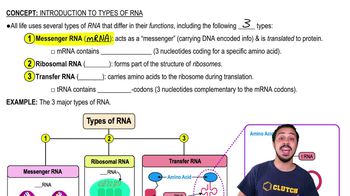Place the following in the most likely order for biosynthesis of a bacteriophage: (1) phage lysozyme; (2) mRNA; (3) DNA; (4) viral proteins; (5) DNA polymerase.
a. 5, 4, 3, 2, 1
b. 1, 2, 3, 4, 5
c. 5, 3, 4, 2, 1
d. 3, 5, 2, 4, 1
e. 2, 5, 3, 4, 1
 Verified step by step guidance
Verified step by step guidance



Place the following in the most likely order for biosynthesis of a bacteriophage: (1) phage lysozyme; (2) mRNA; (3) DNA; (4) viral proteins; (5) DNA polymerase.
a. 5, 4, 3, 2, 1
b. 1, 2, 3, 4, 5
c. 5, 3, 4, 2, 1
d. 3, 5, 2, 4, 1
e. 2, 5, 3, 4, 1
A viral species is not defined on the basis of the disease symptoms it causes. The best example of this is
a. polio.
b. rabies.
c. hepatitis.
d. chickenpox and shingles.
e. measles.
List the four properties that define a virus. What is a virion?
A virus with RNA-dependent RNA polymerase
a. synthesizes DNA from an RNA template.
b. synthesizes double-stranded RNA from an RNA template.
c. synthesizes double-stranded RNA from a DNA template.
d. transcribes mRNA from DNA.
e. none of the above
Label the principal events of attachment, biosynthesis, entry, and maturation of a + stranded RNA virus. Draw in uncoating. <IMAGE>
Which of the following would be the first step in the biosynthesis of a virus with reverse transcriptase?
a. A complementary strand of RNA must be synthesized.
b. Double-stranded RNA must be synthesized.
c. A complementary strand of DNA must be synthesized from an RNA template.
d. A complementary strand of DNA must be synthesized from a DNA template.
e. none of the above